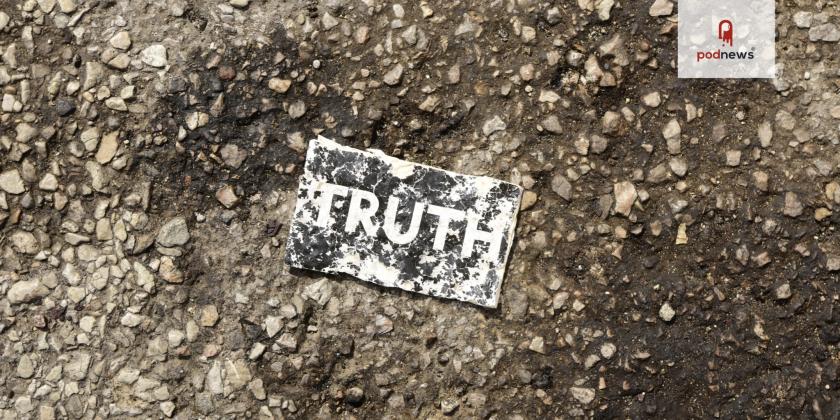
Spotify vs Apple: who's bigger really?

This article is at least a year old
Libsyn has released their most popular platforms for April, in The Feed. They say that Apple Podcasts is 60.01%; Spotify 13.65% and Google 2.3% of all downloads.
Buzzsprout released their April figures earlier this month: they report Apple Podcasts is 29.3%; Spotify 29.3% and Google 2.8% of all downloads.
Who’s right?
Some of the podcast press will just publish these numbers, different though they are, and move on.
I’d like to think that Podnews is a little different: and I’d rather ask difficult questions to find out what’s really going on, and help people understand whether these numbers are wrong (as some competing podcast hosts have claimed), or whether there’s something to be learnt from them.
After all: it matters. If Spotify is as big as Apple, that’s big news. Given that Spotify seems to have no apparent interest in open standards or the wider infrastructure of podcasting, that might be a concern for the future of the industry. Similarly, if Apple really has thrown away their pioneering lead by being asleep at the wheel and dis-inclined to work with the industry, that’s a story too.
Buzzsprout, to their credit, agree that their numbers are quite different to what others are publishing. In an episode of Buzzcast, their podcast, they highlight a few things that might explain the discrepancy.
Let’s dig in to the weeds.
AppleCoreMedia
Podnews wrote a piece explaining what AppleCoreMedia is, and what it means for podcast stats. In short, according to Podnews’s stats, 58% of AppleCoreMedia downloads were verifiably from Apple Podcasts. Or, if you like it better that way, 42% weren’t.
Buzzsprout’s Kevin Finn: “I think it’s very possible that the way that other podcast hosts have been tracking numbers for a long time [are] attributing a lot more plays to Apple Podcasts than we believe is the most accurate way.”
Buzzsprout’s “most accurate way” is to remove all AppleCoreMedia figures from their released stats.
For their customers, Buzzsprout breaks out AppleCoreMedia traffic, called “Unknown Apple Apps”. They don’t, though, publish this “Unknown Apple Apps” numbers in their global stats for some reason. I asked - and, according to the company, AppleCoreMedia accounted for 15.2% of all downloads in March.
By contrast, I suspect that Libsyn includes all AppleCoreMedia stats in their overall Apple numbers.
While Libsyn do break out AppleCoreMedia and iTunes in their customer stats, their overall figures given in The Feed are for “the Apple Podcasts app, iTunes, and the Apple Podcasts ecosytem”. I asked Libsyn whether the figures they quote in their public overall stats also includes AppleCoreMedia, and shared with them a version of this article. They wouldn’t confirm what this number includes or doesn’t include: preferring to give a statement instead1.
- Buzzsprout ignores all AppleCoreMedia plays, so the figures are too low
- Libsyn includes all Apple ecosystem plays as Apple Podcasts, and we suspect all AppleCoreMedia plays too, so the figures are too high
Libsyn’s numbers are measuring different things to Buzzsprout
While Libsyn wouldn’t comment about what their numbers include, here’s what I do know about Libsyn’s numbers: they’re not IAB Certified numbers (the company has previously confirmed this to me); and that they are for “mobile aggregator apps” only.
I can’t correct for the fact they’re not IAB Certified - the reasons for the company using these, incidentally, is that many Libsyn customers don’t pay extra for IAB numbers.
However, I can correct for the fact that they’re for “mobile aggregator apps only”.
In The Feed, Walch also states that 86.5% of downloads were to mobile devices in April. So, all their market share figures are certainly 14.5% too high.
- Buzzsprout’s figures are based on the entire ecosystem
- Libsyn’s figures are only based on mobile devices
Let’s correct the numbers then
Buzzsprout removes all AppleCoreMedia downloads from their downloads. Assuming their AppleCoreMedia number from March of 15.2% of all downloads hasn’t changed in April, that’s 12m AppleCoreMedia downloads.
Our data is that 58% of those AppleCoreMedia numbers are really from Apple Podcasts. 58% of 12m is an additional 6,978,131 downloads from Apple Podcasts.
So, including Apple Podcasts’s share of AppleCoreMedia, our final correct number for Buzzsprout is:
- Apple Podcasts: 38.1% (30,208,102)
- Spotify: 29.3% (23,180,132)
- Google Podcasts: 2.8% (2,212,395)
Libsyn's numbers are for mobile downloads only; so let’s start by correcting the numbers down to also include the 14.5% of non-mobile downloads. That brings the overall numbers down to Apple: 51.9%; Spotify 11.8% and Google Podcasts 2.0%.
Libsyn’s numbers for Apple Podcasts includes Apple iTunes (1.1% of all Buzzsprout downloads). Removing those from the main Apple Podcasts numbers makes the figures Apple: 50.8%; Spotify 11.8% and Google Podcasts 2.0%.
And we now need to remove AppleCoreMedia’s non-Apple numbers. Assuming the numbers are similar to the way Buzzsprout and Podnews breaks them out, then our final corrected numbers for Libsyn are:
- Apple Podcasts: 42%
- Spotify: 11.8%
- Google Podcasts: 2.0%
Those numbers are closer. But they’re still not the same; especially Spotify. So what’s up?
The types of shows
Finn again: “Another possibility is that the the shows that happen to be using Buzzsprout as their podcasting platform are skewing more towards whatever type of people use Spotify. I don’t know exactly what that demo looks like, except that I think it skews a little bit younger.”
We know that comedy and sport works very well on Spotify: there’s lots of data showing that (Podigee shared some with us last year), and Spotify certainly skews younger in audience.
According to our sample, Buzzsprout has 1.7x more sports shows in Spotify than Libsyn does, as a percentage of their total. The number of Spotify shows about “arts” from Buzzsprout is 7.5x the size of those from Libsyn.
If Buzzsprout’s shows appeal to Spotify listeners more, they’ll get more listening from that platform. And it would seem that, for whatever reason, the genres in Buzzsprout are those that over-index for Spotify listeners.
But here’s another theory.
Being on Spotify at all
If Buzzsprout’s Spotify figures are bigger than Libsyn’s, that might be solely because Buzzsprout has more shows in Spotify.
From our sample, 87.8% of Buzzsprout shows are in Spotify. For Libsyn, that number is just 56.5%.
If you have 1.5x more shows on Spotify, your figures from Spotify will be 1.5x higher: that stands to reason.
In Buzzcast, Finn compares the two: “To submit your podcast to Spotify is one click and probably about five minutes … Apple, you have to have an AppleID, you have to be able to login, you have to pass the validation system, which is intermittent at best of how well it’s working on any given day. And then once you get through that, then it goes into an approval process, they have some sort of human approval process on their end, it can take anywhere from two or three days, up to a couple of weeks. And so you wonder how many people who are getting started … have gotten stuck somewhere in that process, and never finished it or gotten the approval or whatever. And so it could be significant.”
I asked Buzzsprout whether they had any more data around this. Finn responded: “Out of Buzzsprout’s 101,485 current 'active’ podcasts, 75,593 (74.4%) are listed in Spotify and 60,467 (59.5%) are listed in Apple.” Only 60% of their shows are in Apple Podcasts!
And, there’s another difference.
Being a new podcast
Libsyn has a long and proud history of being an independent podcast host. Many of their customers have been with the company for a long time.
Buzzsprout is a younger company, and appears to be growing fast. According to ListenNotes from mid-Dec 20 to mid-Mar 21, Libsyn added around 2,400 podcasts; but Buzzsprout added more than 12,000.
According to our overall sample, 79.7% of podcasts with an episode in the last six months - on whatever host - are in Spotify. However, only 51% of podcasts last published longer ago than six months are in Spotify.
In short: podcasts that are newer are more likely to be in Spotify: and Buzzsprout has more of those.
Country differences
We do know that Spotify performs better in non-US territories: particularly because Apple Podcasts is currently only available on iOS devices, and not Android. As I’ve reported previously, Android has 68% of the European market and 86% of the South American market.
52.6% of downloads from Buzzsprout are from outside the US. Only 38.3% of downloads for Libsyn are from outside the US. With 14.3% more show downloads from outside the US, Buzzsprout will show a higher number for Spotify than Libsyn.
So, who’s figures are correct?
Libsyn’s numbers aren’t IAB certified, are for mobile downloads only, and I suspect they also incorrectly include AppleCoreMedia in Apple Podcasts’ numbers. Libsyn’s figures make Apple Podcasts appear much larger than it is.
Buzzsprout’s numbers are IAB certified. However, they don’t include any AppleCoreMedia traffic in Apple Podcasts’s numbers, which I also feel is incorrect. Buzzsprout’s figures make Apple Podcasts appear a bit smaller than it is.
The issues with the data from both companies, however, doesn’t account for the full disparity between the numbers. There are significant differences between shows on the two hosts; and, arguably, highlight the future of the podcast industry - one where Spotify is the market leader, not Apple.
Is that a good thing? Well, that’s a different discussion entirely.
=====
Footnotes
1: Libsyn’s statement to us, in full:
We appreciate the opportunity to comment and respect that there will always be differences in trends reported from other platforms and those that reflect Libsyn’s valued customers. We will continue our commitment to support each podcaster’s understanding of their specific audience through our advanced stats and the overall user-agent numbers we see on the Libsyn platform. Libsyn continues to invest in the ever-evolving landscape of podcast and monetization tools and open them to more podcasters of every level of experience or chosen host.
I’m grateful to Buzzsprout for their willingness to engage with me while writing this article, and also grateful to Libsyn for supplying their comment.
Disclosures: Both Buzzsprout and Libsyn are supporters of Podnews. I produce a podcast, Podland, which is sponsored by Buzzsprout; they have no editorial input into that podcast (indeed, Libsyn’s Elsie Escobar was on a recent edition). Neither companies have any input into the contents of Podnews. I am also an advisor for Captivate, a competing podcast host (who don’t release overall data). Full disclosures are here.































































































